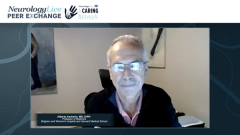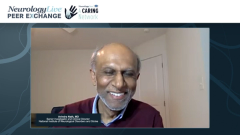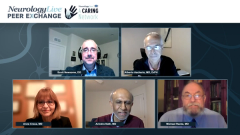
Elucidating the Association Between Epstein-Barr Virus and Multiple Sclerosis
Alberto Ascherio, MD, DrPH, recaps key findings and learning from a recently published study that he coauthored demonstrating a causal relationship between MS and Epstein-Barr virus.
Episodes in this series

Scott Newsome, DO: Hello, and thank you for joining us for this special Neurology Live® Peer Exchange. Today we’ll be discussing the practical and clinical implications of a recent novel published study, the first of its kind, drawing the association between multiple sclerosis [MS] and EBV [Epstein-Barr virus]. Joining me is a wonderful group of experts with different vantage points: 1 of the main authors of the study, Dr Alberto Ascherio, a professor of medicine at Brigham and Women’s Hospital and Harvard Medical School in Boston, Massachusetts; Dr Anne Cross, a professor of neurology and chair of the division of neuroimmunology at Washington University in St. Louis [Missouri]; Dr Avi Nath, a senior investigator and clinical director of the National Institute of Neurological Disorders and Stroke; and Dr Mike Racke, the medical director for neurology at Quest Diagnostics [in Seacaucus, New Jersey] and a past president of the CMSC [Consortium of Multiple Sclerosis Centers]. I’m Scott Newsome, a neurologist from Johns Hopkins Medicine in Baltimore, Maryland.
Let’s get started. At center stage, the star of the show is Alberto, because of this wonderful study that you and your team recently published. Could you describe to the audience why you thought this study was so important to pursue? Can you also provide us with a CliffsNotes version of the study design, methods, and anything else you want to tell us about the study?
Alberto Ascherio, MD, DrPH: Thank you for the introduction, Scott. The idea that EBV is related to MS has been around for a long time, but it’s been an idea difficult to sell to most MS specialists. Until now, MS was considered an autoimmune disease of unknown etiology, and only a few of us consistently tried to put EBV within the picture. One reason it’s so difficult is that EBV is a nearly ubiquitous virus. The common thought is that because it infects nearly everybody, how can it be the cause of MS, which affects only 1 of 300 people? I always found that question a bit puzzling, because I say, “Do you think if everybody was a smoker, cigarette smoking would cease to cause lung cancer?” Obviously not. The difficultly is more in demonstrating the link. Conceptually, it’s not that something ubiquitous can cause a rare disease, which is a common occurrence for many viruses. But how do you prove it?
This is the first study that could rely on a very large population of EBV-negative individuals who weren’t infected with EBV. These were young adults who could be followed prospectively, and we could see in an experiment of nature whether those who get infected have a different risk of developing MS compared with those who aren’t infected. The results are striking. If you’re not infected with EBV, you virtually don’t get MS. It’s only after EBV infection that your risk of MS jumps more than 34-fold.
The study concept is very simple. It took 20 years to conduct in collaboration between multiple institutions, with multiple obstacles in the course. But the concept is basic, comparing EBV-negative with EBV-positive subjects. We included several controls. One is cytomegalovirus [CMV], which is transmitted in a similar manner to EBV. We used that as a negative control. We found that with individuals infected with CMV, there’s no relation to MS. The occurrence of MS is entirely independent from CMV infection. If anything, CMV seemed to have a very modest protective effect on the occurrence of MS.
We also looked at neurofilament light chain [NfL]. The neurofilament light chain in serum is a sensitive biomarker of neurodegeneration. It’s not specific for MS, but when you get an elevation in serum NfL, it suggests that something is happening in the brain, that it’s the beginning of a pathological process. The reason we measure NfL is because there’s a prodromal period in MS. The common objection we got when we were presenting the hypothesis of EBV in MS was, “How can you exclude the possibility that those individuals who have prodromal MS and a dysregulated immune system are more likely to get infected with EBV?” NfL helps establish the temporal sequence. In individuals who develop MS, we see that it’s EBV infection first followed by NfL elevation and later by MS onset. We never see NfL elevation preceding EBV infection. This strengthened the evidence that EBV comes first and the beginning of the pathological process is secondary in time to EBV.
Finally, because several infectious agents have been proposed as being related to MS, we looked at the overall antibody response against human viruses—over 100,000 peptides that cover all the pathological human viruses—and we compared the antibody responses between MS cases and control with the same age, sex, and ethnicity. We found that the peptides that differentiated MS cases from the controls were only EBV peptides. I was surprised by how striking the results were. I expected a lot of noise and false-positive heat with different peptides from different viruses, but the response to EBV is so strong that it overwhelmed everything else. Only EBV peptides stood out in MS. Putting everything together, I don’t think there’s any other plausible explanation, so I’m pretty convinced about this. I’ve seen people expressing concern in the media. I’m yet to hear someone proposing an alternative explanation other than EBV causing MS.
Scott Newsome, DO: Thank you. I enjoyed reading your paper. You broke it down very nicely. I was going to ask you a couple of questions, which we’ll get to later. But I know there are some challenges when you do studies like this where people will think that there’s an association vs a cause and effect, which I’m sure is some of the constructive criticism that comes your way. Because if you show an association, that doesn’t necessarily mean there’s a causal link. But we’ll hear a little later from colleagues about that. In your view, what is the most significant piece of your paper? You mentioned that this is 20 years in the making, which is quite impressive. I don’t think people understand how much goes into work like what you guys did. What are the top 2 most significant things of your study?
Alberto Ascherio, MD, DrPH: The key observation is that your risk of MS is 0 until you get infected with EBV. If I may comment on your question of association, it makes a big difference when you’re looking at an association that’s a 20% increase compared with 1.2 or 2 and a relative risk of 30. When an association gets to a certain level, at some point you find that you don’t have an alternative explanation. A good example is smoking and lung cancer. There’s no experimental evidence of randomized people to smoking or not smoking. It’s an association, but it’s an association that’s been accepted. The link between several viruses and other diseases before the vaccine became available has also been based on association studies, so the strength of the association is 1 of the basic elements.
As we said in the paper, confounding is the beast that people are concerned about in epidemiological studies. To induce a relative risk of 30, a confounder would need to have an association with MS, increase the risk of MS by over 64 times, and be correlated with increased risk of EBV infection by over 64 times. I haven’t heard anyone proposing anything coming remotely close to something that could have the strengths of association with both the exposures and the outcome of interest.
Scott Newsome, DO: Thank you. You mentioned CMV as being a control. In the pediatric world, there have been some works looking at EBV and CMV and the relative association or protective effect.
Transcript Edited for Clarity
Newsletter
Keep your finger on the pulse of neurology—subscribe to NeurologyLive for expert interviews, new data, and breakthrough treatment updates.







































